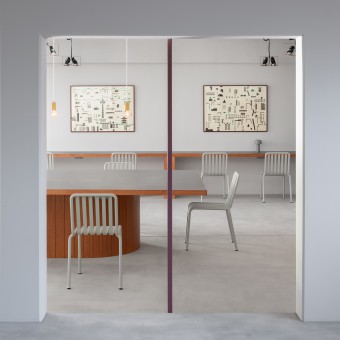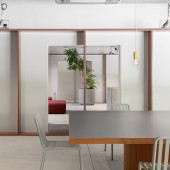Nippon Shinyaku Koku Office Space by Reiichi Ikeda |
Home > Winners > #145492 |
 |
|
||||
| DESIGN DETAILS | |||||
| DESIGN NAME: Nippon Shinyaku Koku PRIMARY FUNCTION: Office Space INSPIRATION: Incorporating the idea of “tuzuk UNIQUE PROPERTIES / PROJECT DESCRIPTION: We designed the free address space inside the headquarters of Nippon Shinyaku, a pharmaceutical company headquartered in Kyoto Prefecture. It was planned for a corner of a vast site near Nishioji station, where several office buildings stand side by side. To commemorate the 100th anniversary of the company’s founding, the project began in late 2019. However, it had to be stopped temporarily due to the unprecedented spread of the novel coronavirus. It was finally completed in the summer of 2021. OPERATION / FLOW / INTERACTION: First, we increased the boundary between the inside and outside by incorporating diagonal lines ub the form of a V-shape for the glass walls, which previously ran parallel. Then, we made the boundary area between the inside and outside ambiguous by taking the floor tiles, which had originally been designed for an outside environment, and allowing them to overflow into the inside space, even biting into the V-shaped glass walls. What’s more, the process of repeated expansion throughout the company’s long history turned the exterior of the building a reddish-brown. This view of the site and its colors express the ongoing process in this change in color, as though it is changing the building’s interior as well. In order to categorize the scene, we incorporated the idea of the “tsuzukiai” present in the sukiya style of building. Thus, steel frames that trace the outlines of the fusuma (Japanese paper sliding doors) are scattered along the span of the skeleton beams. As such, these walls are not just function, like ensuring privacy or sound insulation. Rather, they aim to create an open space while controlling the consciousness of lookers on to emphasize the gentle form of the individual areas. It is perfect for spending your time as you see fit. PROJECT DURATION AND LOCATION: Construction began in Kyoto on April 13, 2021 and was completed on July 27, 2021. FITS BEST INTO CATEGORY: Interior Space and Exhibition Design |
PRODUCTION / REALIZATION TECHNOLOGY: Main finishing material Floor: mortar base with magnetic tiles, mortar metal trowel holder Walls: PB groundwork AEP, round pillars/mortar metal trowel holder, wall frame/ST assembly baking paint, curtain/lace fabric crease processing Ceiling: Existing slab base AEP Fixtures: Big table/legs/magashiro wood dyed finish, top plate/melamine veneer pasted (K-6305/Aica Kogyo), counter/exposed concrete finish Lighting equipment: Brass custom-made pendant lighting (vao place) SPECIFICATIONS / TECHNICAL PROPERTIES: Area:369.8 square meters TAGS: office, interior, japan, kyoto RESEARCH ABSTRACT: 1.By inserting the same tiles as the outdoor tiles into the interior, the boundary points between the inside and outside are controlled by the design. 2. Based on the traditional Japanese concept of "continued room", we scattered frames that traced the outline of the fusuma. 3. Since all the buildings on the premises are reddish brown, the interior is also affected and the process of dyeing everywhere is expressed. CHALLENGE: While capturing the background of Kyoto, we aimed to create a place that is conscious of connecting the left behind interior to the outside, from the environmental conditions that the building does not face the public road as in the past. ADDED DATE: 2022-09-30 05:48:34 TEAM MEMBERS (14) : design/REIICHI IKEDA DESIGN Reiichi Ikeda, partner/Aji Architects Tomoko Nagahiro, lighting/Modulex Jun Ikeda, bgm/Espec Junji Ozono, curtain/fabricscape Kiyohiko Yamamoto, green/Bond Satoshi Tanii, art/Tokuhiro Kano, funiture/inter office Akio Hayashi, custom lighting/vaoplace Hirohumi Oba, interactive Satoshi Kamewaka, sign/kantaro Midori Hirota, Constructor/Kanazawa Contruction Hideki Kanazawa, Photographer/Yoshiro Masuda and Photographer:Yoshiro Masuda IMAGE CREDITS: Photographer:Yoshiro Masuda |
||||
| Visit the following page to learn more: https://reiichiikeda.com/?p=1594 | |||||
| CLIENT/STUDIO/BRAND DETAILS | |
 |
NAME: Nippon Shinyaku Koku PROFILE: Nippon Shinyaku aims to be a company that is trusted and respected by society as an essential business entity in the healthcare field. |
| AWARD DETAILS | |
 |
Nippon Shinyaku Koku Office Space by Reiichi Ikeda is Winner in Interior Space and Exhibition Design Category, 2022 - 2023.· Read the interview with designer Reiichi Ikeda for design Nippon Shinyaku Koku here.· Press Members: Login or Register to request an exclusive interview with Reiichi Ikeda. · Click here to register inorder to view the profile and other works by Reiichi Ikeda. |
| SOCIAL |
| + Add to Likes / Favorites | Send to My Email | Comment | Testimonials | View Press-Release | Press Kit | Translations |
Did you like Reiichi Ikeda's Interior Design?
You will most likely enjoy other award winning interior design as well.
Click here to view more Award Winning Interior Design.







